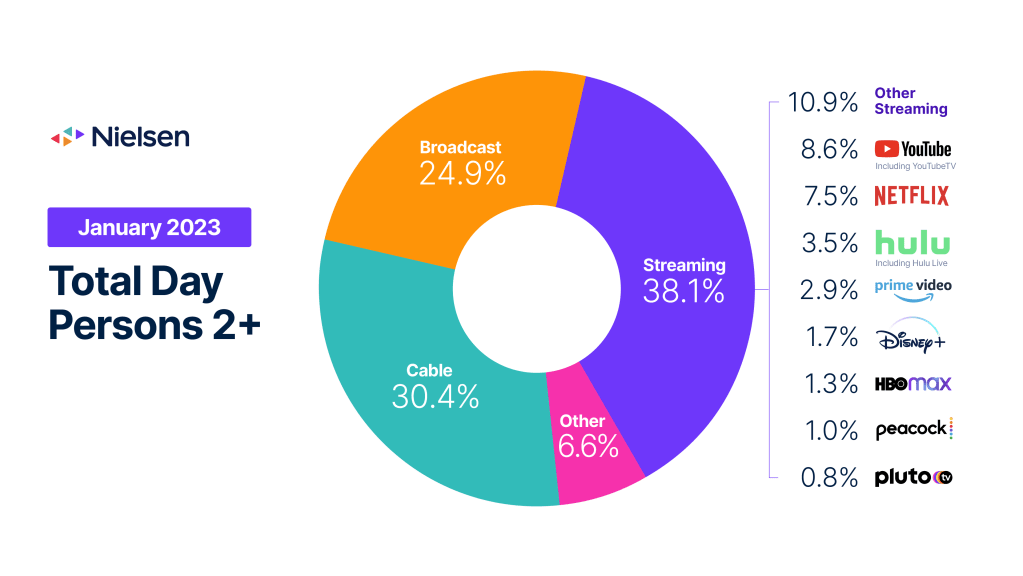If there’s one big takeaway from January TV viewing trends, it’s that new, in-demand content will always draw a crowd. And when high-demand content spans multiple channels, total usage increases. That’s what happened in January, as a surge of viewership for broadcast dramas, sports and new streaming content pushed total usage of TV up 1.3% compared with December.
Across TV options, broadcast benefitted the most from the usage increase, as dramas and sports drove a 2.1% increase in broadcast usage. Across the category, viewing to dramas rose 29% from December to accountfor 23.5% of the total and sports jumped a whopping 55% to pull in 25.3%, with the NFL playoffs capturing the 10 most-viewed programs during the month. On a year-over-year basis, however, broadcast viewership was down 6.0%.
Streaming usage increased 1.2% from December 2022, with Amazon Prime Video gaining 9.3% in usage. The arrival of a new season of Jack Ryan and the movie Shotgun Wedding helped Prime Video gain 0.2 share points to end the month with 2.9% of total TV. Hulu (including Hulu Live) was up 2.9% in usage and added 0.1 share points.
While Netflix’s share of TV held steady at 7.5%, the end of the holiday season had an impact on Disney+ , which declined 9.9% and lost 0.2 share points.
Cable usage was flat compared with December, as a 22% increase in sports usage couldn’t make up the gap left by the 19% decline in cable movie viewing—an additional viewing trend associated with the closing of the 2022 holiday season.

Methodology and frequently asked questions
The Gauge provides a monthly macroanalysis of how consumers are accessing content across key television delivery platforms, including broadcast, streaming, cable and other sources. It also includes a breakdown of the major, individual streaming distributors. The chart itself shows the share by category and of total television usage by individual streaming distributors.
How is ‘The Gauge’ created?
The data for The Gauge is derived from two separately weighted panels and combined to create the graphic. Nielsen’s streaming data is derived from a subset of Streaming Meter-enabled TV households within the National TV panel. The linear TV sources (broadcast and cable), as well as total usage are based on viewing from Nielsen’s overall TV panel.
All the data is based on a time period for each viewing source. The data, representing a broadcast month, includes a combination of Live+7 viewing for the reporting interval (Note: Live+7 includes live television viewing plus viewing up to seven days later for linear content).
What is included in “Other”?
Within The Gauge, “other” includes all other TV. This primarily includes all other tuning (unmeasured sources), unmeasured video on demand (VOD), streaming through a cable set top box, gaming and other device (DVD playback) use. Because streaming via cable set top boxes does not credit respective streaming distributors, these are included in the “other” category. Crediting individual streaming distributors from cable set top boxes is something Nielsen continues to pursue as we enhance our Streaming Meter technology.
What is included in “other streaming”?
Streaming platforms listed as “other streaming” includes any high-bandwidth video streaming on television that is not individually broken out.
Where does linear streaming contribute?
Linear streaming (as defined by the aggregation of viewing to vMVPD/MVPD apps) are included in the streaming category and represented 5.3% of total television in December 2022. Broadcast and cable content viewed through these apps also credits to its respective category.
Do you include live streaming on Hulu and YouTube?
Yes, Hulu includes viewing on Hulu Live and YouTube includes viewing on YouTube TV.
Encoded Live TV, aka encoded linear streaming, is included in both the broadcast and cable groups (linear TV) as well as under streaming and other streaming e.g., Hulu Live, YouTube TV, Other Streaming MVPD/vMVPD apps. (Note: MVPD, or multichannel video programming distributor, is a service that provides multiple television channels. vMVPDs are distributors that aggregate linear (TV) content licensed from major programming networks and packaged together in a standalone subscription format and accessible on devices with a broadband connection.)



